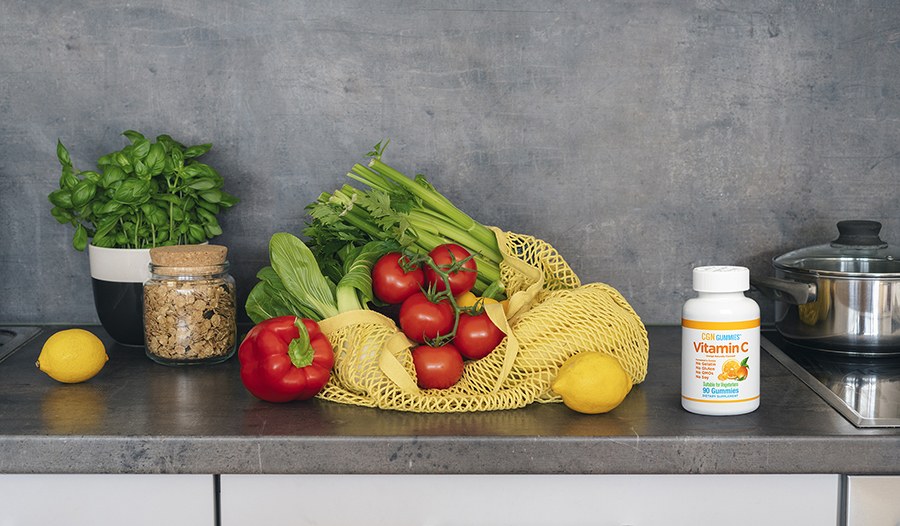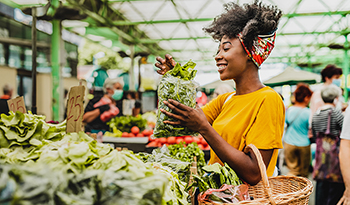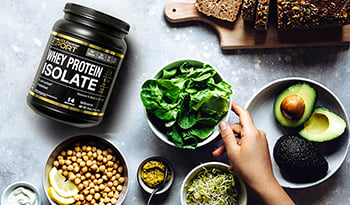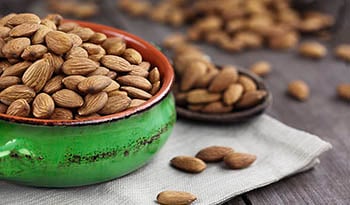Top 10 Plant-Based Foods to Eat This Summer
DISCLAIMER:This blog does not intend to provide diagnosis...
- In this article:
- Specific Nutrients for Warmer Weather Months
- Eat Seasonally
- Seasonal Produce Provides More Nutrients
- Top 10 Plant-Based Foods for Summer
- Takeaway

The weather is getting warmer—and that means it's time to enjoy the summer sun and all the delicious foods that come with it! Fresh produce is one of the best parts of summer—juicy watermelon, plump strawberries, sweet peaches, and tomatoes picked fresh from the vine are just a few of the season’s gems you should be sure not to miss! When you’re craving something a bit heartier after an active day in the sun, grilled tofu kebabs or veggie burgers are the perfect way to round out a summer barbecue.
Many foods are perfect for summer eating, but I have narrowed it down to my top 10 favorite picks. These foods are not only nutritious, but they also taste great and are perfect for any summer occasion.
Specific Nutrients for Warmer Weather Months
As the seasons change, so do your nutrient needs. In warmer months you likely spend more time outside playing sports, gardening, or doing other activities that make you sweat more. With sweat loss comes a need to replenish.
Likewise, sun exposure from time spent outdoors in the summer sun can damage your skin. The most effective way to protect your skin is by wearing sunscreen and sun-protective clothing while outdoors, but certain nutrients may help lessen the damage from UV rays.
Be sure to load up on these key nutrients your body needs even more during the summer months:
- Electrolytes: You lose important electrolytes, like sodium, potassium, calcium, and magnesium when you sweat. Try adding an electrolyte powder to your water to keep yourself well-hydrated and replace essential minerals lost through sweat.
- Vitamin C: Some studies suggest vitamin C may help prevent skin damage from ultraviolet rays.9 Be sure you get enough of this powerful antioxidant after a day in the sun.
- Vitamin D: It may seem like you wouldn’t need to worry about getting enough vitamin D during the summer months—it is the sunshine vitamin after all! But studies show that 42% of people in the US are deficient in vitamin D.10 So don’t neglect this important vitamin just because the days are sunnier.
Eat Seasonally
Summer is the season of fresh-picked fruits and vegetables. Seasonal fruits and veggies are picked at peak ripeness and move quickly from the farm to your table. As a result, they are more delicious and nutritious than produce that was shipped around the world before arriving on your plate.
Eating seasonal produce is also typically more affordable and, as an added bonus, helps support the local farmers who grow your food.
There are many reasons to eat local, seasonal produce—but my favorite is that it just plain tastes better! And summer is the peak time to get delicious, affordable, fresh fruits and vegetables that simply aren’t available other times of the year.
Seasonal Produce Provides More Nutrients
You may be surprised to learn that eating seasonally gives you more nutrients than eating out of season. When fruits and vegetables are in season, they contain more vitamins, minerals, and antioxidants than when they’re not in season. This is because local produce is picked at the peak of ripeness and doesn’t have to travel far to reach your table.
Many nutrients decrease over time after a fruit or vegetable has been picked—so produce that has been shipped long distances or stored over time has lost some of its nutrient content by the time it reaches your table.1
Summer produce is especially good for you since it contains high levels of vitamin A and vitamin C, which are important for immunity, skin health, and eye health. Seasonal fruits and vegetables also tend to be lower in calories and higher in water content, making them a great pick.
If you have a local farmers market nearby, stop by to see what’s available before heading to the grocery store. Not sure what exactly is in season during the summer? Here is a list of some of the best seasonal summer foods to add to your list.
Top 10 Plant-Based Foods for Summer
1. Watermelon
Watermelon is the perfect summer food not only because it's in season, but also because it's 90% water. With its high water content, watermelon is hydrating and refreshing—perfect for a hot summer day.
Don’t believe the myth—eating the seeds will not make a watermelon grow in your stomach! Packed with vitamins A and C and the powerful antioxidant lycopene, what’s not to love about this quintessential summer fruit?
2. Tomatoes
Tomatoes always taste best picked fresh from the vine in summer. They are easy to grow in a home garden and are full of antioxidants that may help protect your skin from damage that can be caused by the sun.
Tomatoes are also a great source of lycopene (just like the watermelons). Generally, the richer the red color of a tomato, the more lycopene it has.2
One of the best ways to enjoy tomatoes is on a grilled veggie burger.
3. Berries
Berries like raspberries, strawberries, and blackberries are the perfect summer food because they're light, refreshing, and full of antioxidants. Research has shown that berries can protect cells against oxidative stress from free radicals.3 In fact, one study found that blueberries, blackberries, and raspberries have the highest levels of antioxidants of commonly eaten fruits.4
Enjoy berries on their own as a healthy snack or use them to brighten up a summer salad. They’re perfect in a smoothie, on top of non-dairy yogurt, or in homemade ice pops.
4. Corn
Sweet corn is a classic summer food and is perfect for barbecues and picnics. If you’re lucky enough to live in the Midwest, you’ll have no trouble finding great-tasting sweet corn this summer!
Sweet corn isn’t just a summer staple, it offers a variety of health benefits. Corn is a good source of fiber, which can help regulate digestion and prevent constipation. And it is rich in vitamins A and C, which are essential for maintaining healthy skin and eyes. The potassium in corn helps keep blood pressure in check.
5. Cucumbers
Cucumbers are the ultimate refreshing and hydrating food. They are made up of 96% water, making them an ideal food to eat when you are trying to stay hydrated in the summer heat.5 While most of our hydration comes from fluids, about 20% comes from water-rich foods, like cucumbers.
Not only are they full of water, but cucumbers also have important electrolytes like potassium and sodium, which can help replenish your body after a long day in the sun. Cucumbers are also a good source of vitamins A and C.
6. Peaches
Peaches are the summer must-have fruit. Sweet and juicy, there is no more perfect food for eating on a hot day than a juicy peach.
Peaches may be able to help your skin retain its moisture.6 They are also a good source of vitamins A and C, as well as fiber.
I love enjoying perfectly ripe peaches fresh. But peaches are also delicious in vegan peach pie, peach crisp, a rustic peach galette, or even cut in half and grilled with a sprinkle of cinnamon.
7. Eggplant
Eggplant is a good source of fiber, vitamins C and K, copper, manganese, and thiamin. It also contains phytonutrients that have been linked with a reduced risk for chronic disease.7
Some feel intimidated or unsure of how to prepare eggplant, but it is quite a versatile veggie! Eggplants are delicious baked, grilled, on veggie kabobs, or used in recipes like ratatouille or vegetarian moussaka. They are even hearty enough for a simple grilled or roasted, plant-based eggplant Parmesan.
8. Bell Peppers
Peppers are a good source of vitamins A, C, and B-complex. In fact, bell peppers offer significantly more vitamin C than citrus fruits. They also have fiber, copper, and manganese.
Bell peppers come in several different colors, from green to yellow to red. Green peppers are actually unripe, which explains why they taste less sweet than yellow or red peppers. Some people even describe the taste of green bell peppers as bitter. Red bell peppers are much sweeter, so may be a better choice for snacking. No matter the color, peppers can be eaten raw, roasted, or made into salsa.
9. Lemon
Lemons are tart, acidic, and tangy. They are known for their high levels of vitamin C as well as flavonoids.
For plant-based eaters, lemons are particularly beneficial as their high vitamin C content helps increase the absorption of iron from other plant foods when eaten together.8 Good plant-based sources of iron include red lentils and leafy greens.
Lemon brightens the flavor of both sweet and savory dishes. And remember—when life gives you lemons, make lemonade!
10. Beans
Beans are an excellent source of plant-based protein, fiber, and iron. They come in all shapes, sizes, and colors. You can find them dried or canned at your local grocery store. Some popular beans include black beans, kidney beans, lentils, and chickpeas. Beans can be used in a variety of dishes and are a great addition to summer salads or grilled vegetables.
Bonus #11. Water
Water isn't technically a food, but it deserves an honorable mention as a summer essential! Staying well-hydrated is particularly important in the summer heat when we tend to sweat more. Without adequate fluid, our bodies cannot function properly.
Keep a reusable water bottle filled with fresh, cold water on hand during the summer months to ensure you are drinking enough—the general recommendation is to aim for at least eight glasses of water a day. If you don’t love the taste of water, consider adding a slice of lemon, orange, cucumber, or other fruits, veggies, or herbs for a refreshing, hydrating infusion.
Takeaway
Summer is a season of abundance for delicious, local, plant-based foods. These top picks are not only tasty, but they will help you stay hydrated and cool, and provide you with the nutrients your body needs to thrive during the summer months.
Add some of these delicious seasonal staples to your grocery or farmers' market lists this summer. From watermelon to berries, tomatoes to zucchini, there’s something here for everyone to enjoy!
References:
- Rickman JC, Barrett DM, Bruhn CM. Nutritional comparison of fresh, frozen and canned fruits and vegetables. Part 1. Vitamins C and B and phenolic compounds. Journal of the Science of Food and Agriculture. 2007;87(6):930-944. doi:10.1002/JSFA.2825
- Arias R, Lee TC, Logendra L, Janes H. Correlation of lycopene measured by HPLC with the L, a, b color readings of a hydroponic tomato and the relationship of maturity with color and lycopene content. J Agric Food Chem. 2000;48(5):1697-1702. doi:10.1021/JF990974E
- Rahal A, Kumar A, Singh V, et al. Oxidative stress, prooxidants, and antioxidants: the interplay. Biomed Res Int. 2014;2014. doi:10.1155/2014/761264
- Wolfe KL, Kang X, He X, Dong M, Zhang Q, Liu RH. Cellular Antioxidant Activity of Common Fruits. Journal of Agricultural and Food Chemistry. 2008;56(18):8418-8426. doi:10.1021/JF801381Y
- Guelinckx I, Tavoularis G, König J, Morin C, Gharbi H, Gandy J. Contribution of Water from Food and Fluids to Total Water Intake: Analysis of a French and UK Population Surveys. Nutrients. 2016;8(10). doi:10.3390/NU8100630
- Koikeda T, Tokudome Y, Okayasu M, et al. Effects of Peach (Prunus persica)-Derived Glucosylceramide on the Human Skin. Current Medicinal Chemistry. 2017;17(1):56. doi:10.2174/1871522217666170906155435
- Cham BE, Chase TR. Solasodine rhamnosyl glycosides cause apoptosis in cancer cells. Do they also prime the immune system resulting in long-term protection against cancer? Planta Med. 2012;78(4):349-353. doi:10.1055/S-0031-1298149
- Ballot D, Baynes RD, Bothwell TH, et al. The effects of fruit juices and fruits on the absorption of iron from a rice meal. Br J Nutr. 1987;57(3):331-343. doi:10.1079/BJN19870041
- Kawashima S, Funakoshi T, Sato Y, et al. Protective effect of pre- and post-vitamin C treatments on UVB-irradiation-induced skin damage. Sci Rep. 2018;8(1). doi:10.1038/S41598-018-34530-4
- Parva NR, Tadepalli S, Singh P, et al. Prevalence of Vitamin D Deficiency and Associated Risk Factors in the US Population (2011-2012). Cureus. 2018;10(6):e2741. Published 2018 Jun 5. doi:10.7759/cureus.2741

 By Rhyan Geiger, RDN
By Rhyan Geiger, RDN


